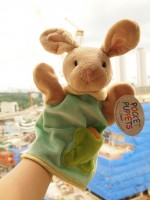 Puppets are powerful to young children. They are magical, which could be why I like them so much too! A few years ago, I had to face it. I am not as cool as a puppet. It’s fine, really. Who wouldn’t like a colorful, soft animal that moves and talks?
Puppets are powerful to young children. They are magical, which could be why I like them so much too! A few years ago, I had to face it. I am not as cool as a puppet. It’s fine, really. Who wouldn’t like a colorful, soft animal that moves and talks?
I have been incorporating puppets for as long as I have taught toddlers and preschoolers and I have seen first hand their benefits. From inviting children into the dance room to singing a special song, the puppet becomes a teacher too. Below I have broken down some of the benefits and offer some ideas for incorporating puppets in the dance room.
Transition
Using puppets for transitions works wonders! They may not listen to you but I can guarantee they will listen to the puppet. Puppets can motivate a child to get up and continue on with class. Sometimes you alone are not enough to engage every child. I use the puppet for help in transitioning students from one place in the room to another. Maybe the puppet takes them through their home as they get to the other side of the room, or maybe the puppet’s favorite game is follow the leader. Ever since I added a puppet to just one transition during a 45 minute class, things got a lot less chaotic.
Break Outta That Shell
Puppets are welcoming and can offer a sense of comfort to your young dancers. If you have dancers who are skeptical of dance class on the first day or have trouble separating from their grown-up, try a puppet to ease their fears. If you show that the puppet isn’t scared, most likely the child will enter the classroom and join in! Use them to open up shy students, allowing them time to break out of their shells.
Focus
At the peak of the class when everyone gets wiggly and chatty, give a puppet a big entrance! Immediately you will find the puppet captures their attention. Guide the students to focus in on the details of the puppet. What color is it? What’s the face look like? How does it move? What does it sound like? Using the puppet as a tool to reel your students back in is a creative way to get them to focus and in turn listen to what you want them to do.
A few things to remember when using puppets in your preschool classes:
1) Have a clear goal of why you are using the puppet. Know what the puppet will add to the song, story, or rituals of the class. Just because the dance you are doing is about a bear doesn’t mean you need a bear puppet. Overdoing it will take the magic out of it. Have a few key puppets and that is all you need.
2) Create rituals with the puppets. You already know that children respond well to repetition, so use it to your advantage. Every time you bring out the puppet you say the same thing and you do the same thing. Rituals will help keep things calm, collected and more fun.
3) Create relationships between the puppet and the dancers. Instead of you, the teacher, complimenting on the students dancing, have the puppet do it. Show that their puppet friend is watching and that they care as much as you do.
Examples of what I love to do with the puppets:
1) Belly kisses: Dancers want to show that they love the puppet by giving them kisses, but that’s a great way to spread germs that nobody wants! Instead, I say this puppet (or the puppet name) gives belly kisses. I kiss them right on their belly button. They love it so much.
2) Happy Taps: The puppet visits each student to see if they are happy. If they are happy they get a tap, if they are not happy they get a tap to instantly make them smile! It’s my way of allowing every student to touch and see the puppet. Basically, everyone gets a happy tap. 🙂
3) Sleeping puppet: Shhh! Sometimes I like to pretend the puppet is asleep. “How should we wake him up?” I ask. I listen to all of the ideas. Then we decide on how to wake them up.
4) Whispers: I love to have the puppet whisper in everyone’s ear. Then I ask them “What did he say?” The answers are so good and hilarious!
Puppets are a wonderful way to develop a dance beyond just the movement and back you up when you need a little help. Invest in a few solid puppet friends. You won’t regret it!
Do you use puppets with your young dancers? How do you incorporate them into class?
A passionate advocate for early childhood dance education, Maria Hanley Blakemore specializes in teaching ages 0 months to 6 years. She left NYC, where she designed and implemented programs at Manhattan’s Jewish Community Center, Dancewave Center and The Mark Morris Dance Group, to teach dancers in the greater Cleveland area. Maria holds a Master’s degree in dance education from New York University (2007) and a Bachelor’s degree in dance performance from Slippery Rock University in Pennsylvania (2005). Maria authors the blog Maria’s Movers (www.mariasmovers.com) where she shares creative ideas and strategies for teaching young dancers. Maria served on the Dance/NYC Junior Committee for 2 years and presented at the 2012 Dance USA Conference. She also presents at the Dance Teacher Summit in New York City. Read Maria’s posts.

